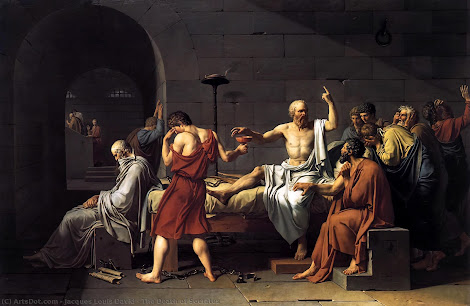Paul's Post 3/18 Classical Era
The Classical Era spanned roughly from the late 18th to the early 19th century. During this era, art served as a reflection of the prevailing moral, social, and political views of the time. Artists during this period were deeply influenced by the Enlightenment, which emphasized reason, rationality, and the pursuit of knowledge. However, they also grappled with the moral complexities and ethical dilemmas inherent in human existence, resulting in works that explored themes of morality, and the human condition.
The Death of Socrates by Jacques-Louis David, painted in 1787, exemplifies the philosophical aspirations of the Classical era. Set in ancient Athens, this work depicts the scene of Socrates' execution by hemlock poisoning. Socrates, the renowned philosopher, is portrayed calmly accepting his fate, surrounded by his grieving disciples. The work serves as a powerful meditation on the importance of intellectual integrity and moral courage, as Socrates chooses death over compromising his principles. David's emphasis on the moral virtues of wisdom, integrity, and defiance against tyranny resonated with the Enlightenment values of reason and individual liberty, making the painting a quintessential example of Classical moral art. To me, this piece elicits feelings of admiration and determination for Socrates' cause.
The Raft of the Medusa by Théodore Géricault created between 1818 and 1819, emerged in the aftermath of the French Revolution and the Napoleonic Wars, during a period marked by political upheaval and social unrest. The painting depicts the harrowing true story of the survivors of the shipwrecked frigate Medusa, who were left adrift on a makeshift raft in the Atlantic Ocean. In this piece, Géricault's canvas captures the desperation, suffering, and resilience of the survivors, while also critiquing the incompetence and corruption of the ruling authorities of the time. Through its powerful portrayal of human suffering and endurance, The Raft of the Medusa is a poignant reminder of the moral imperative to confront injustice and uphold human dignity (Claire, 2021), resonating with the era's growing emphasis on humanitarianism and social justice. This work feels like it emphasizes the consequences of societal indifference within society overall.
The Third of May 1808 by Francisco Goya was completed in 1814 and emerged during a tumultuous period in Spanish history, marked by the Peninsular War and the atrocities committed by Napoleon's troops during the occupation of Spain. The painting depicts the summary execution of Spanish civilians by French soldiers during the Dos de Mayo Uprising in Madrid. Goya's visceral depiction of the brutal violence and human suffering conveys a profound sense of moral outrage and condemnation, while also celebrating the heroism and defiance of the Spanish people in the face of oppression. The Third of May 1808 stands as a powerful indictment of war, tyranny, and the abuse of power, embodying the era's heightened awareness of the moral responsibilities of individuals and nations in the face of injustice and oppression (Artchive, 2019).
References:
Black McCoy, Dr. Claire. “Théodore Géricault, Raft of the Medusa.” Smarthistory.org, 27 May 2021, smarthistory.org/theodore-gericault-raft-of-the-medusa/.
Artchive. “The Third of May 1808 by Francisco Goya – Artwork Analysis – Artchive.” Artchive, www.artchive.com/artwork/the-third-of-may-1808-by-francisco-goya/.




I wanted to comment on your blog because I haven't seen two of the pieces you chose before so they were really interesting. I find The Raft of Medusa neat. I had to do some research to find out more. The raft's theme of human suffering invoked some compassion and empathy which helped to project the image way beyond anything that the artist could have ever hoped for. When I first looked at the painting I could tell right off that it is a Baroque due to the lighting of the painting. It helps to create the drama in this piece. The third painting you chose The Third of May was another I had never seen. It is another powerful painting that shows sacrifice and martyrdom. While also shows the cold hard facts of war. The killing of prisoners. The artist makes sure to use lighting and colors to his advantage to get your eye to look right at the guy who is in the white shirt which also is a symbol in itself. You really shared some great pieces from the classical period that show some of the themes of the era. Thank you so much for sharing these really neat pieces of artwork that I haven't seen.
ReplyDeletehttps://smarthistory.org/art-historical-analysis/